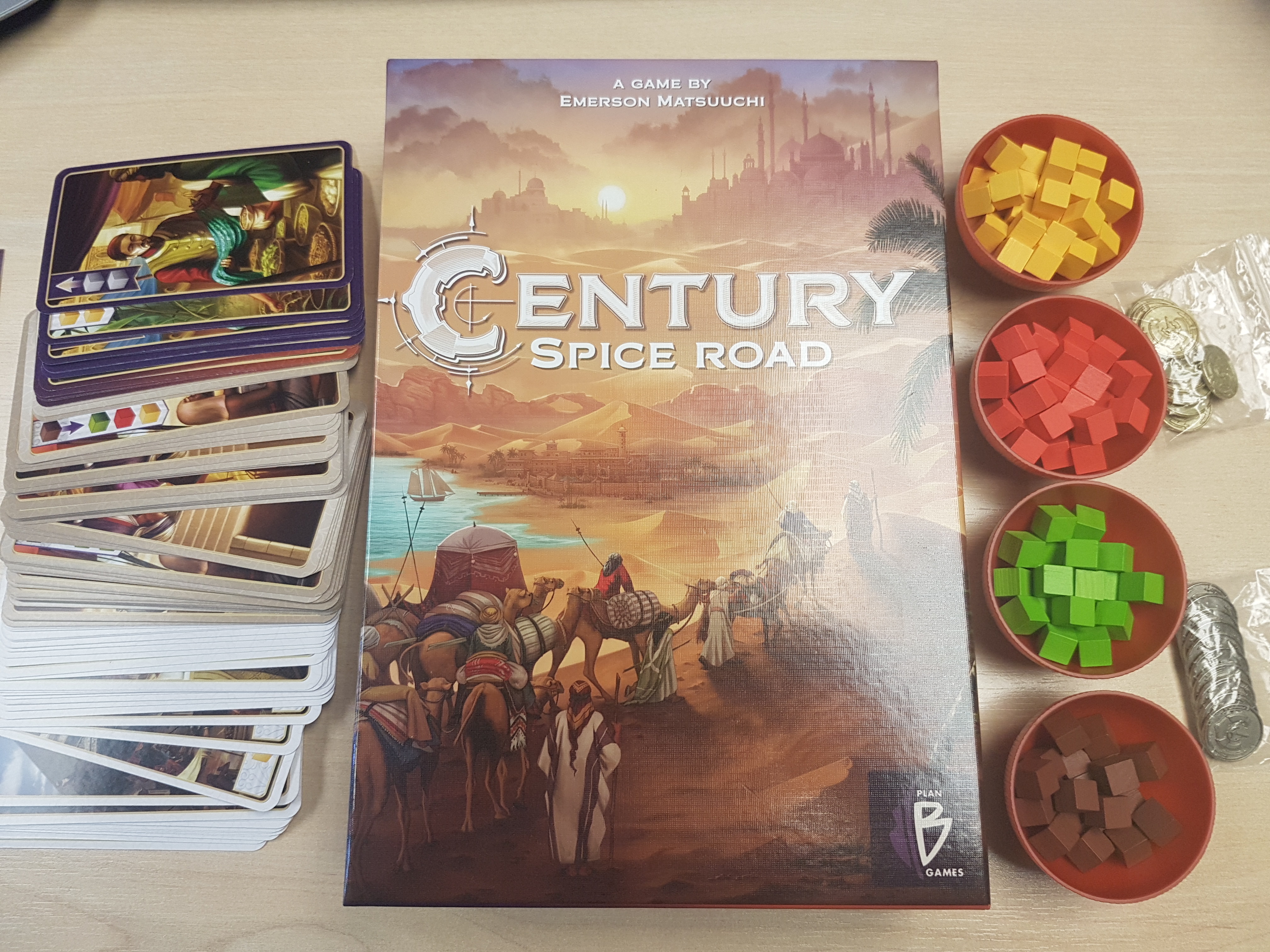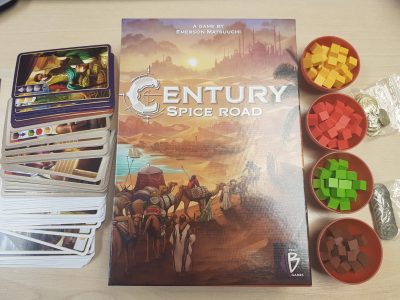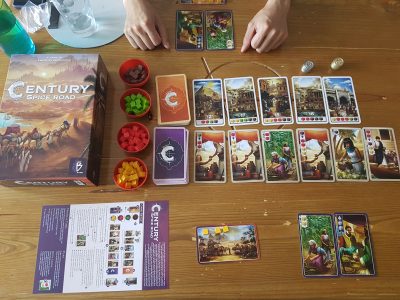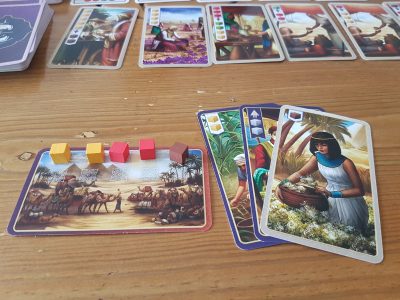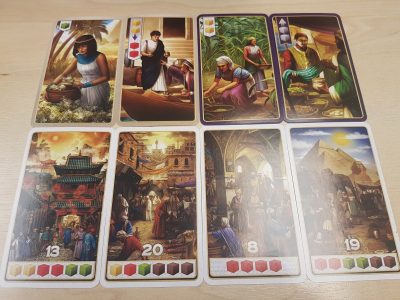Century Spice Road is the first of a series of board games from designer Emerson Matsuuchi. This instalment of the series focuses on spice trading and the ancient trading route, the Silk Road. Players take up the role of merchants leading caravans, whom establish routes, trade or harvest spices and fulfil orders. However, will players want to participate in the spice trade in the days of old or is this some best left to the history books? Let’s find out!
The aim of Century Spice Road is to obtain combinations of the spices to trade in and claim point cards. Players will need to play cards to gain or trade up resources, purchase new cards to help them on their quest and beat their opponents to the combinations. Players start with the same two basic Merchant cards to start their engine building experience. This helps kick-start the process whilst keeping things balanced from the offset. This starting hand is made up of a simple take 2 yellow (turmeric) cubes from the pot and an upgrade two cubes card. These cards alone won’t get player too far overly quickly, thankfully there are a range of other merchant cards players could obtain.
On a turn, players can do one of four actions. Play a merchant card, take a new merchant card, purchase a Point card or rest. Merchant cards come in three general types. The first is the gain type like the take 2 yellow cubes of the starting hand. These can range from take 4 yellows all the way up to taking 1 brown (cinnamon) cube, which is usually the hardest cube type to acquire. The second type is an upgrade card, again similar to the upgrade cubes card from starting hand. The last and most prevalent type comes with a trade cube function. These massively range in input and outputs but for example a merchant card could see a player trading in 2 green (cardamom) cubes for 2 red (saffron) cubes and 2 yellow cubes. These offer players the ability to split apart perceivably more expensive resources into a greater number of lesser cubes. In a way, the sum of the parts are greater, nevertheless it all depends on the combinations you need.
To play a merchant card players just need it in their hand, they then either turn it over or put it in their discard pile to show it has been spent. The cards effects then take place. To get these cards back players must take the rest action, returning all cards from their discard pile back to their hand. Instead of playing a card or resting, players can also purchase new merchant cards. There are always 6 to pick from. The catch is only the furthest one from the merchant deck is free. To purchase cards higher up, towards the deck, players must put a single cube of any type on top of each card they are skipping. If anyone takes a card with cubes on it they obtain the cubes along with it and whenever a card is taken the rest slide away from the deck to fill the gap and a new card is drawn.
This cube cost is important early on in the game where the first player starts with less cubes than player 2 & 3, whom in turn start with less valuable cubes than players 4 & 5. This means the first player cannot always instantly grab an awesome looking merchant card. As time goes on the first-place advantage wears away, they may get the first points card but towards the end of the game others will have had plenty of opportunity to have either caught up or overtaken them.
To purchase a point card players need the denoted cube combinations of one of the 5 point cards on show. When one is taken the remaining 4 slide down and a new card is exposed. Generally, the longer it’ll take players to get a combination the more points it’ll award. A card costing 2 green cubes and 3 red cubes will award less than a card costing 5 brown cubes, as the order is yellow upgrades to red, red upgrades to green and finally green upgrades to brown. An extension of the rules is that the 4th and 5th card from the point deck have silver and gold coins on them respectively. These coins give bonus points at the end of the game. The game goes until one player has purchased their fifth point card where the game ends, points are totalled and the winner announced.
Some players have found Century Spice Road a bit repetitive in the middle of the game. This was when they were still building up, but this occurs in all the best engine builders out there. By the end of the game, when it is crunch time, the process of playing cards, earning cubes and maximum efficiency feels less rinse and repeat more urgent. Especially when you need just those last couple cubes, in a mad rush! More often than not players gravitate towards trading in for the same card resulting in some fun last minute grabs for different point cards to just score some additional points before the game ends.
There is some light engine building strategies available to players in Century Spice Road. These normally boil down to either a utilizing only a few merchant cards and gunning for early points or going heavy on the merchant cards, so that late on you can churn out ample cube combinations. Players are free to go into the game with a preference but they will have to adapt depending on the merchant cards which become available to them. Others may be able to obtain the merchant cards you want before you, so staying flexible is often a great approach.
The theming of Century Spice Road is more than pleasant in its visual appeal. The artwork on the merchant and point cards are visually different to make the distinguishable and clear, whilst still having a range of eye-catching artwork. Alas, as with most engine builders it feels like you could paste on a different theme and the game would still make as much sense. To strengthen the theme it would have been nice to see small details on the coloured cubes, denoting the spices, but this is being overly picky.
What isn’t being overly picky is that Century Spice Road suggests that cinnamon and cardamom are more expensive than saffron. This is because the cubes become increasing more difficulty to obtain as you go from yellow to brown. This to me just suggests that the theming has been tacked on as an afterthought despite being driven deep and interwoven into the games lore. Another afterthought are the metal coins which I’m split on. They feel nice to the touch, yet considering they are hardly utilized it seems an unnecessary inclusion, that’ll just bump the cost of the game up for everyone.
Is this the Splendor-killer that some have called it? Not entirely. They are similar in feel but for now both keep their space on my gaming shelf. Mechanically, the spending of the cards and the difference in scoring points helps to separate the two enough for my liking. There is a simplicity to the building of cube combination and the merchant card abilities that makes Century Spice Road instantly accessible. There is also enough player choice, of whether to splash out for higher cards and which cards to use in what order, to have light strategies emerge. Despite it’s somewhat light feel I’ll certainly be attending the market for Cinnamon, Cardamom, Saffron and Turmeric spices for some time to come!
[Editor’s Note: Century Spice Road was provided to us by Esdevium Games for review purposes. The game is currently available on 365 Games for £31.99. It is also available from local UK board game stores, find your local store here]

